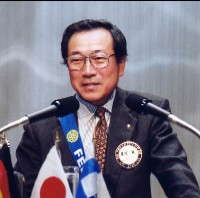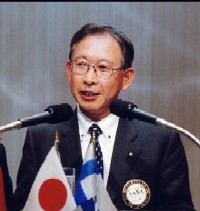Initiation Speech
April 14th, 2004
Mr. Takeshi Kurioka
Vice President of the Mitsui Sumitomo Maritime Fire Insurance Co. Ltd.
Mr. Takamitsu Takebayashi
President of Fourteen, Ltd.
 Two initiation speeches were made at the meeting of April 14. The first speaker was Vice President Takeshi Kurioka of the Mitsui Sumitomo Maritime Fire Insurance Co. Ltd., who spoke on the Science of Hole-in-Ones: A Hole-in-One is every golfer��s dream, but its reality is little known. Our firm started selling ��Golfer��s Insurance�� policies in April 1960, and as we progressed into the late 70��s with the growth of the custom of holding parties, giving mementos when one scored a hole-in-one, we started selling insurance which would cover costs in case of such a case.
Two initiation speeches were made at the meeting of April 14. The first speaker was Vice President Takeshi Kurioka of the Mitsui Sumitomo Maritime Fire Insurance Co. Ltd., who spoke on the Science of Hole-in-Ones: A Hole-in-One is every golfer��s dream, but its reality is little known. Our firm started selling ��Golfer��s Insurance�� policies in April 1960, and as we progressed into the late 70��s with the growth of the custom of holding parties, giving mementos when one scored a hole-in-one, we started selling insurance which would cover costs in case of such a case.
Since then, we have added cover for albatross and other cases, and today I would like to speak from this experience on the science of hole-in ones. According to an English statistic, a golfer can make one hole-in-one playing 11,000 rounds of golf. This is a tenth of the percentage for golf pros, and 4.66 times the chance of winning 3rd prize in our year-end lottery.
According to the Guinness Book, the longest drive for a hole-in-one is 408 meters, the highest frequency 47 times, the youngest aged is 4, and the highest is 99.
Among Japanese pro golfers the highest male is Hanekawa with 7, and among females, Takamura, Imabori, Shioya and Kin Manju have all scored 6.
Other related odd topics: John Murphy, playing at the Willmer Golf Club in North Carolina hit a hole-in-one at the 7th hole, and repeated the performance the next day. However, on the second day he was playing alone, so there was no witness for the record. The next day he had the golf club manager accompany him to the 7th hole where he again scored a hole-in-one.
According to another statistic, if a once a week player plays for 20 years, one in eleven score a hole-in-one; if playing twice a week, one in six will do the same.
According to our own statistics, a distance of 130-150 yards scores the most hole-in-ones, with the use of No.6 to No.8 clubs.
Ceremonies after the event, 82% of those scoring held a celebration party, and the most used mementos were pre-paid cards 39% and decorative gifts 13%.
These costs were covered by our policy, and the payment ranged from 300,000 to 500,000 yen in most cases.
Regarding golf insurance overseas, such policies are not valid if you are playing at a golf club of which you are a member. If your firm is awarding prize money to pro golfers for hole-in-ones, we can arrange an insurance policy for you, so let us know.
 The second speaker was Mr. Takamitsu Takebayashi, President of Fourteen, Ltd. Regarding change in golf clubs, they are due to evolution and vogue. Vogue arises from the urge to use the type of golf club that the best pro is using, and if he changes clubs, so does the vogue. This is the same among pros and amateurs.
The second speaker was Mr. Takamitsu Takebayashi, President of Fourteen, Ltd. Regarding change in golf clubs, they are due to evolution and vogue. Vogue arises from the urge to use the type of golf club that the best pro is using, and if he changes clubs, so does the vogue. This is the same among pros and amateurs.
Evolution of golf clubs have 3 reasons:
1. Higher performance due to applied physics
2. Higher performance due to better design
3. Higher performance due to improved materials and production techniques
1 concerns physics and dynamics. The larger the inertia moment, the better its function. For the past 20 years golf club makers throughout the world have made this their most important theme for developing drivers.
What merits has a golf club with a large inertia moment have for the golfer? Even when a golfer misses, the ball will fly well without curving.
Another factor of physics is the head repulse coefficient factor. By improving this the drive was extended for a maximum of 16 meters. However, new rules have been enforced, allowing its use to only female pros and amateurs. Furthermore, its use will be prohibited in 2008.
2 Formerly, the designing of golf clubs were left up to master craftsmen but today, computer 3DCAD is taking their place. However, there are problems such as the difficulty in designing the delicate curved lines preferred by pros. In our firm we are training club designers, but they must first experience making cast moldings before learning 3DCAD design.
As for production techniques, at first titanium heads were limited to 200cc but today their average volume is close to 400cc, and the largest 460cc.
Six years ago, trying to get a titanium head of 300cc produced, I visited titanium foundries around Japan but found that this was impossible. So were foundries in Taiwan, the U.S. and China where I visited. But only 5 years later, these foundries were able to produce 400cc heads.
Finally, the world��s golf club production today is 50 million a year, with China manufacturing 45 million or 90% of the total.